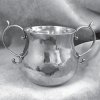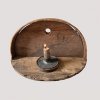Julia Anchors Maine Auction Week at over $5 Million
August 26th, 2016
James D. Julia, Fairfield, Maine
For the last several decades the keystone of Maine’s unofficial antiques auction week in August has been James D. Julia’s multimillion-dollar blowout. This year it happened August 24-26 in Fairfield, Maine, and included about 2000 lots that made over $5 million in sales, with about three-quarters of all offerings finding new homes.
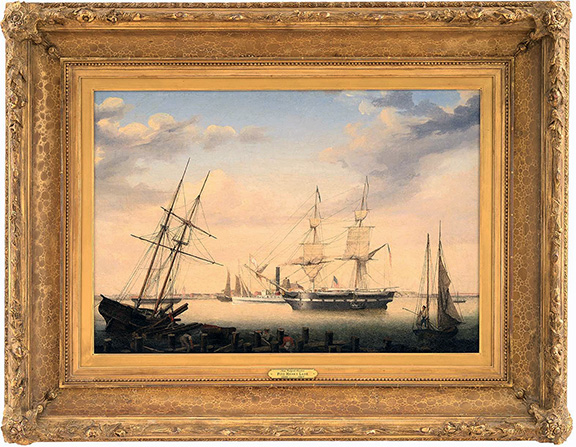
This oil on canvas by Fitz Henry Lane of the harbor in New Bedford, Massachusetts, was the clear frontrunner of the sale at $296,250.
Julia photo.
Only three items made it into the six-figure territory, led by an unsigned Fitz Henry Lane (1804-1865) oil on canvas scene of the side-wheeler Massachusetts, an unidentified two-masted whaling ship, and a beached two-masted schooner offloading a cargo of logs. It was framed in a gilt gesso decorated frame with an inset metal tag reading “Eli Wilner & Co. Period Frames & Mirrors” and an Alexander Gallery, New York, label affixed to the back. The painting is scheduled to be included in the online Fitz Henry Lane catalogue raisonné being published by the Cape Ann Museum. Restored but still in need of some attention, the painting fell just shy of the ponderous $300,000/500,000 estimate at $296,250 (includes buyer’s premium).
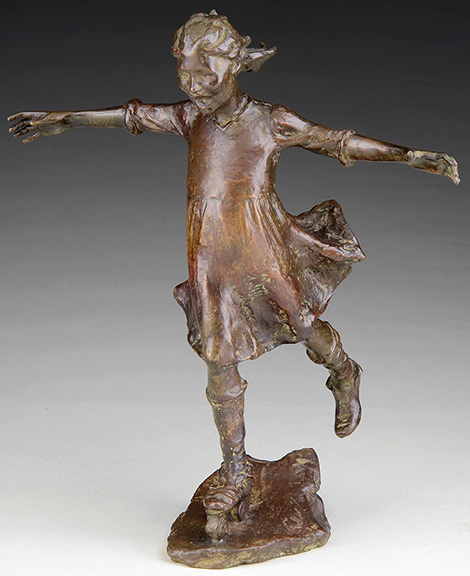
This bronze sculpture of a freewheeling girl on a roller skate by Abastenia St. Leger Eberle sold for $20,145. Julia photo.
Abastenia St. Leger Eberle (1878-1942) was an American sculptor whose most famous piece, The White Slave, portraying an auctioneer selling a naked child, condemned child prostitution and caused a violent controversy when it was exhibited in 1913. Some of her other works represented working-class children from the Lower East Side of New York City, such as the bronze sculpture of a young girl gliding on a single roller skate offered in this sale. According to one of Julia’s assistants, there are only three known examples extant of this sculpture, and according to the catalog listing, this is the only one to come to auction in recent history. Reportedly the consignor discovered it in a secondhand shop with one arm broken off. He contacted the foundry and had another one made that was nearly indistinguishable from the original. The result was a relatively subdued $10,000/15,000 estimate and a solid sale at $20,145.
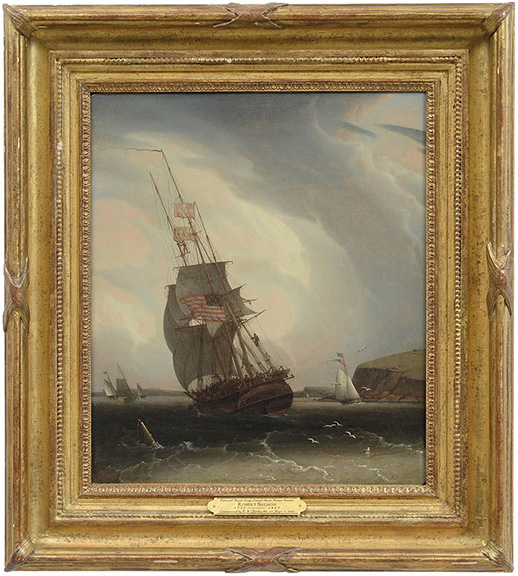
This oil on wooden panel by Robert Salmon of the packet Lintin made $82,950. Julia photo.
The circumstances of the life of British artist Robert Salmon (1775-c. 1848) belie the extent of his artistic importance. From about 1811 to 1820, he moved back and forth between London and Scotland. Then in 1829, he immigrated to the United States, where for the next dozen years or so, he lived in a shack overlooking Boston harbor, where, it is estimated, he produced between 300 and 400 works. His precisely detailed paintings were reminiscent of the traditional Dutch marine style, and his influence extended to such artistic luminaries as Fitz Henry Lane, William Bradford, and Alfred Thompson Bricher. An oil on wood panel of an American vessel under partial sail beneath a slate-gray sky was signed bottom right “RS 1832.” On the back was “No. 760 / Painted by R. Salmon” above two more crisp old ink-written paper inscriptions. A previous owner identified the ship as the packet Lintin, a 390-ton bark built by Sprague and James in Medford, Massachusetts, in 1830. The Lintin sailed to China under Captain Robert Bennet Forbes. Forbes was a prominent Boston merchant and shipbuilder who gained much of his wealth from the opium and China trade, and he was believed to be the commissioner and first owner of the painting. The newest owner paid $82,950 (est. $20,000/40,000) for it.
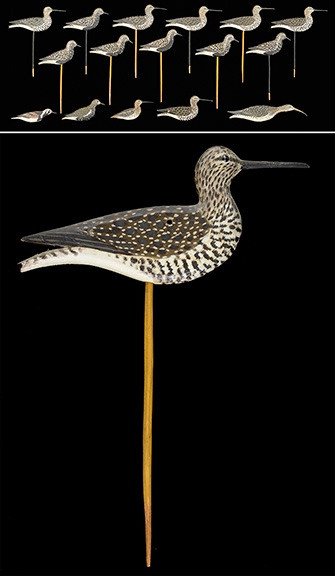
This collection of 16 ruddy turnstone decoys, unsigned but clearly by Elmer Crowell, flew off for $90,060. Julia photos.
 Here’s where some specific knowledge translated into a nifty profit for the consignor. A group of unsigned bird decoys had been cataloged by a non-decoy specialist just before the listing went to print. But when Jim Julia spotted them, he instantly recognized them as silhouette shorebirds produced by Elmer Crowell. It was too late to change the hard-copy catalog but not too late to alter the online version with an addendum. Most of the 16-member set came with the original carrying holes and probably the original mounting sticks. The published estimate was $1000/1500. The result was a cool $90,060. “They’re ruddy turnstones,” Julia told me before the sale, “and nobody’s ever seen one of those. The holes are there because you’re supposed to put a rawhide thong through them, and you can carry thirty of them over your shoulder out into the marsh.”
Here’s where some specific knowledge translated into a nifty profit for the consignor. A group of unsigned bird decoys had been cataloged by a non-decoy specialist just before the listing went to print. But when Jim Julia spotted them, he instantly recognized them as silhouette shorebirds produced by Elmer Crowell. It was too late to change the hard-copy catalog but not too late to alter the online version with an addendum. Most of the 16-member set came with the original carrying holes and probably the original mounting sticks. The published estimate was $1000/1500. The result was a cool $90,060. “They’re ruddy turnstones,” Julia told me before the sale, “and nobody’s ever seen one of those. The holes are there because you’re supposed to put a rawhide thong through them, and you can carry thirty of them over your shoulder out into the marsh.”
For more information, visit the website (www.jamesdjulia.com) or call (207) 453-7125.

This oil on canvas by Edward Willis Redfield (1869-1965) turned out to be a big winner. The winter scene of a snow-covered mountaintop overlooking a distant valley, signed “E.W. REDFIELD” lower right, passed the $80,000/120,000 estimate and ended at $148,125. Redfield painted mostly in Bucks County, Pennsylvania, where he was a leader of the New Hope Impressionists. Later in life, he burned hundreds of his own paintings, considering them to be inferior and of little worth. Julia photo.
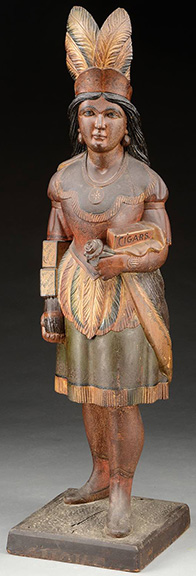
This 56" tall polychromed tobacconist figure of an Indian maiden, circa 1880, attributed to Samuel Robb (1851-1928), holds a rose in her left hand with a box of cigars tucked under her arm. It is believed to have been carved by Robb as a tribute to his late wife, Emma, and the statue became known as “Robb Roses.” It sold well over the $45,000/65,000 estimate for $94,800. Julia photo.
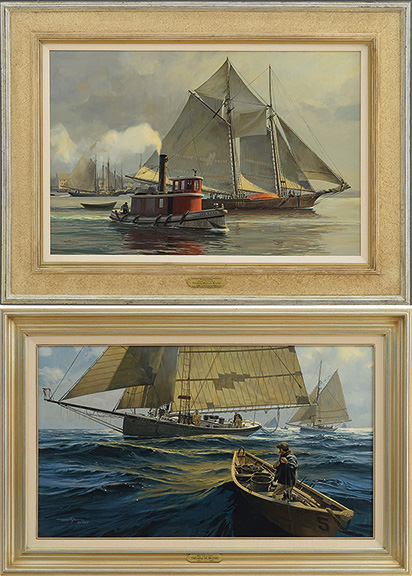
Illinois and Massachusetts artist Thomas Hoyne (1924-1989) served aboard a tank landing ship in the Pacific in World War II. His experiences at sea contributed to his ultra-realistic ship portraits and illustrations. He often went so far as to commission model makers to create models of the ships he intended to paint. He was represented by seven works in this sale, including these two oils on masonite: Dropping the Tow – 1979, showing the tugboat Joe Call leaving the schooner Indiana, and Five to Port, 1983, of the fishing schooner Vesta and a fisherman in a rowboat. Both crushed their $15,000/25,000 estimates and ended at $53,325. Julia photos.
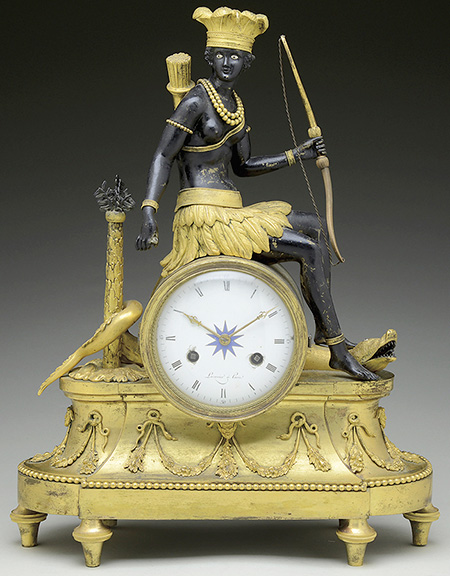
This 18¼" high 19th-century French mantel clock has a seminude small gilded blackamoor female archer figure in a feathered headdress and skirt who sits over a serpent with details right down to its scaly hide. The archer’s piercing white eyes entranced buyers into bidding it up to $17,775 (est. $2000/3000). A script inscription on the clockface indicates the maker or retailer as “Luzurier à Paris.” Julia photo.
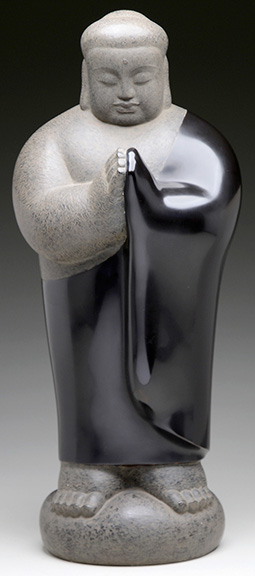
Bidders appreciated this signed 23½" tall contemporary bronze sculpture by 20th-century Taiwanese artist Li Chen (b. 1963) of a standing figure in a ceremonial prayerful pose, combining traditional and modern Buddhist form, to the tune of $38,512.50, more than ten times the $2000/3000 estimate. Julia photo.
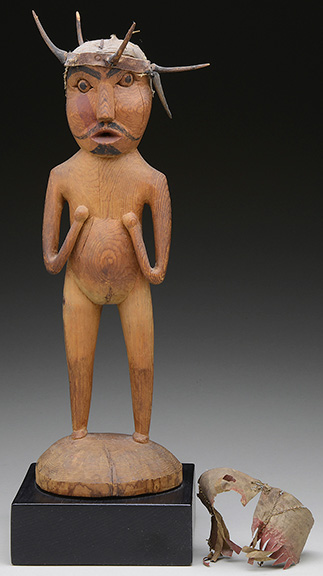
Among the Native American works, this 16" high carved Kwakiutl shaman figure in cedar, with strangely formed arms, a face with a painted moustache and beard, and a slightly damaged thorn headdress sailed over the $4000/6000 estimate to land at $20,145. Julia photo.

This pair of 32" tall (sight size) porcelain plaques by Wang Dafan (1888-1961) dates from the Republic period of China. This lot was one of three lots to go over the six-figure mark, selling for $118,500 (est. $30,000/40,000). Julia photo.
Originally published in the November 2016 issue of Maine Antique Digest. © 2016 Maine Antique Digest






